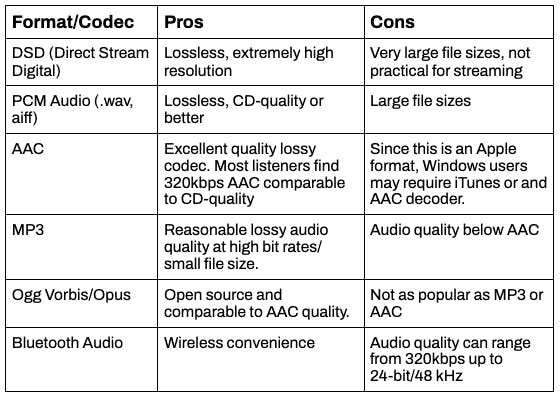By now most of us have opted in to one of the subscription music streaming services and many of us also rely on YouTube for music content streaming. We use these sources for recreation and also for accessing reference music we need in our professional lives as creators. For many years, we’ve had to accept low-quality, lossy formats for portable listening and streaming over slow or data-restricted networks. High-quality audio was reserved for our DAW output and music that we could purchase or rip in hi-res formats. 2021 brings us the luxury of unlimited data caps (for most of us) and streaming services that have entered the modern age of streaming high-quality, lossless audio.
If it’s been a minute since you’ve compared your streaming plan to your needs and desires for high-quality streaming, take some time to revisit what is available and which features you can take advantage of. Three questions should be considered when judging a streaming service: where and how will you be listening, what are your quality requirements/goals, and is streaming enough, or would you also like downloadable music to reference offline.
How and Where Do You Listen?
During a workout, while driving, or while doing yardwork audio quality is not as much a concern as the variety of content. Noisy environments, cheap earbuds, and many Bluetooth devices don’t provide an opportunity to take advantage of high-resolution audio, so if these are your main listening conditions, you might opt for a service with lots of content without much concern for the resolution/quality options.
If you mostly stream on studio monitors/headphones, on a full range home stereo or theater system, or even in many new cars, the quality of your audio stream matters more, as you will be able to discern between low-bitrate codecs and hi-resolution streams.
What Are Your Quality Goals?
If you mainly stream music during your workouts or if you mainly stream podcasts or talk-radio-type content, then the quality of the stream won’t be too much of a concern. If you stream to enjoy the fidelity of music or if you use streaming as a reference for your music production work, you will probably want to opt for a service that provides high-resolution, lossless audio.
Do You Stream or Listen Offline?
At times it may not be convenient or possible to log into a wifi or cell network—like on an airplane or even in a large office building—so you may prefer to download content that you can listen to even when you’re offline. Your device storage may limit the amount of data you can store, which in turn may limit the resolution of the audio you wish to store. Conversely, if you wish to import music into your DAW for reference during your music production sessions, you will certainly want to be able to download lossless audio formats that your DAW can import without much fuss.
Current Audio Formats from Streaming Services
Comparing streaming services can be a bit like shopping for a mattress. Every platform uses unique terminology to describe its content quality making it difficult to compare against other providers. HiRes, HiFi, HiDef, Lossless, Master Quality, CD-Quality, Uncompressed, Standard, Immersive… these are but a few of the descriptors used by various streaming services to assure the customer of the quality they are providing. Furthermore, most record companies and artists provide distributors with only one master, so each platform will convert that master to their own formats.
CD-spec or Hi-Res audio describes audio that is at least 16-bit/ 44.1 kHz PCM audio (.wav or AIFF) files. In all practicality, 16-bit 44.1 kHz masters should sound identical to any higher resolution format. Your own equipment may sound different (due to its own performance limitations) at different sample rates, bit depths, or with different Hi-Res formats, like DSD, but these formats all match or exceed the fidelity of the original master file.
Lossless encoding reduces the size of an audio file by as much as 50%, but no audio data or audio quality is lost when the file size is reduced. Lossless files come in different resolutions, all of which meet or exceed CD-spec. FLAC and ALAC are common lossless audio codecs. Not every audio player or DAW can play or import FLAC/ALAC files without first converting them back to .wav of AIFF.
Lossy codecs reduce the size of an audio file by discarding audio data that can never be recovered, so they will sound inferior to the original source. Lossy codecs (reasonably good-sounding ones) can reduce the file size by as much as 90%. MP3, AAC, Ogg Vorbis, and Opus are commonly used lossy audio codecs.

Immersive Audio formats commonly include Dolby Atmos, Sony 360 Reality Audio, Dolby Digital, and AC-3, and Apple’s Spatial Audio formats. These formats may be lossy or lossless encodings and many audio titles are upmixed, or derived from the original stereo mix electronically, and not produced specifically to be heard as immersive audio. These upmixed or remixed versions are often produced by the distributor and not by the original artist or producer.
Alternative formats, like MQA (currently used by TIDAL) or any other format claiming to provide “master quality” or “music as the artist intended,” should be questioned and likely do not provide the resolution they claim or infer. This is not to say they don’t sound acceptable or even excellent, but their marketing tends to be misleading or false. If you use a service that provides anything except the well-defined lossless or lossy codecs defined above, you should do your own due diligence and listening tests to see if you are satisfied with the audio quality. MQA has been accused of misleading consumers as to its lossless quality claims, but many mastering engineers praise its sound. As the saying goes, “let the buyer beware.”
Many computers and portable devices will not properly play audio formats above 24-bit/48 kHz, so an external DAC (USB, optical, or Thunderbolt) may be required to enjoy the files’ full resolution. Additionally, some formats, like DSD, MQA, FLAC, and ALAC may require specific hardware or software players or format converters for their playback or conversion to a format that you can easily enjoy (or import into your DAW).
To help understand the levels of quality, here is a list of the current streaming formats available and how they stack up. Further down we’ll examine which services provide which formats.

Here are some popular streaming services and their offerings:
Apple Music
Apple Music offers lossless streaming as ALAC with resolutions of 16-bit/44.1 kHz up to 24-bit/192 kHz and lossy streaming at 256kbps AAC
Some music is available in Spatial Audio and ATMOS (iOS 14.6+, macOS 11.4+)
Apple Music provides offline listening options.
iTunes Music Store sells 256kbps AAC files.
TIDAL (multiple plans available)
Masters offers MQA audio, a compressed (lossy) format with excellent audio quality that supports files up to 24-bit 352 kHz. MQA plays back using the TIDAL desktop app or MQA-enabled hardware devices.
Hi-Fi offers lossless encoding (FLAC) with a resolution of 16-bit/44.1 kHz
High quality Offers 320 kbps AAC (the best lossy quality)
Normal offers reduced data rates for slow connections
Immersive Audio offered in Dolby Atmos and Sony 360 Reality Audio (availability varies)
Spotify (multiple plans available)
Web player Free offers 128kbps AAC (lossy)
Web player Premium offers 256kbps AAC (lossy)
Mobile players quality ranges from 24 kbps up to 320 kbps (lossy)
Youtube Music Premium
Music App supports rates between 48kbps AAC and 256kbps AAC (lossy)
YouTube Premium (video membership) Videos provide up to 256kbps AAC audio in stereo or surround formats
Amazon Music (multiple plans available)
Unlimited 320kbps MP3 (lossy)
Unlimited HD Lossless FLAC file equal to 16-bit 44.1 kHz or up to 24-bit up to 192 kHz
Amazon’s Music Store sells downloads in MP3 format
Qobuz
Studio plans stream MP3 or lossless FLAC files up to 24-bit/192 kHz
Provides an offline listening mode
Download Store sells FLAC, ALAC, WAV, AIFF formats
Deezer (multiple plans available)
Free up to 128kbps mp3
Premium up to 320 mp3
HiFi FLAC files (equivalent to 16-bit/44.1 kHz)
Plans provide an offline listening mode
SoundCloud
SoundCloud Go+ 256kbps AAC
Free 64k Opus or 128 mp3
Original quality downloads may be provided by the content owner
Remember
Remember to think about how you will utilize a streaming service and then determine which audio quality you prefer. Then you can determine which service provides the best price vs. performance and if you will need any additional hardware or software to enjoy that service. Lastly, keep in mind that 16-bit 44.1 kHz is considered master quality and anything above that will not improve the sound of a master. Bandwidth is cheap, so enjoy high-quality streaming!




